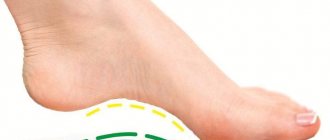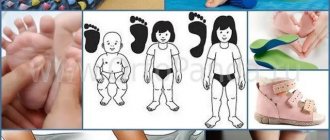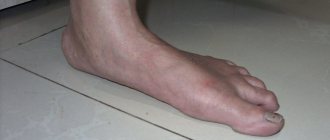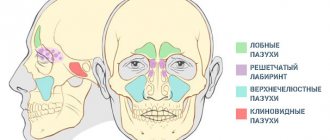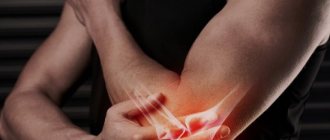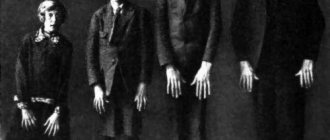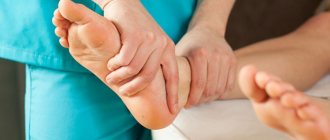From this article you will learn:
- What is transverse flatfoot?
- Types of flat feet
- What are the causes of transverse flatfoot?
- Symptoms of transverse flatfoot
- What to avoid with transverse flatfoot
- Diagnosis of transverse flatfoot
- Treatment methods for transverse flatfoot
- Massage for transverse flat feet
- Treatment of transverse flatfoot at home
- Effective exercises for transverse flat feet
- Prevention of transverse flatfoot
- Orthopedic shoes for transverse flat feet
Transverse flatfoot is diagnosed if, due to certain changes in the arch of the foot of the same name, its functions are reduced - compensating for shock loads during movement and maintaining a state of balance in an upright position.
In fact, the transverse and longitudinal arches of the foot protect our spine and joints from increased stress that can occur when walking, running, etc. That is why it is so important to diagnose the onset of flat feet in time in order to avoid serious threats to health in general.
What is transverse flatfoot?
Transverse flatfoot is a drooping transverse arch, which causes the foot to flatten and come into full contact with the floor. The metatarsals in this case fan out and the big toe deviates outward, causing the foot to become shorter in length. In a healthy person, the foot has arches (curves), which perform a shock-absorbing function and soften any load. Only the correct anatomical structure of the lower extremities allows you to avoid problems in the field of orthopedics.
Most often, people who have been on their feet for a long time know firsthand what it is – transverse flatfoot (grade 1, 2 or 3). At the same time, for those who are constantly in motion, a load is placed on the lower limbs that the ligaments are not able to withstand. In people who are forced to stand on their feet for a long time, on the contrary, the ligamentous apparatus becomes weak. It is worth noting that this happens in most cases (more than 80%). A less common cause of flat feet is a fracture of the foot. Sometimes the development of such a pathology can be affected by rickets, in which weakening of bone tissue is observed.
According to statistics, representatives of the fair sex suffer more often from transverse flat feet than men. As a rule, this is about 50% of patients who turn to a doctor for help. This disease begins to manifest itself at the age of 37–40 years. Thanks to obvious symptoms and effective treatment, transverse flatfoot can be managed at an early stage of development.
Transverse-longitudinal flatfoot, stages
Most often, a combination of transverse and longitudinal flatfoot in both feet is diagnosed. Unilateral damage is usually associated with various injuries. Symptoms vary depending on the extent (stage) of the disease.
- In the first, the ligamentous apparatus weakens, but the foot still retains its natural shape. During this period, a person feels the first unpleasant symptoms after prolonged stress on the legs in the form of burning, fatigue in the limbs, which disappear after rest. For some people, already at the first stage, the gait becomes less flexible.
- At the second stage, changes in the foot in the form of flattening of the arches are visible to the naked eye. It becomes wider, spread out, and in the area of the thumb you can notice a small protruding tubercle. The pain becomes constant, spreading above the foot to the lower leg and knee joint. The gait changes even more - clubfoot occurs.
- At the third stage, the changes are sharply expressed, which provokes degenerative-dystrophic lesions of the joints. The disease also affects the condition of the spine, especially the intervertebral discs, which can cause osteochondrosis, intervertebral hernias, and curvature of the spine. Pain in the limbs accompanies a person constantly and gets worse all the time. At this stage, a person’s performance decreases and even walking short distances causes difficulties.
Types of flat feet
There are three types of disease according to the location of the vaults:
- Transverse flatfoot – characterized by a shortened, lowered transverse arch and an enlarged anterior part.
- Longitudinal flatfoot - here the length is increased and the longitudinal bend is decreased. Most often, this type of pathology affects people aged 15–26 years.
- Longitudinal-transverse flatfoot (combined). This type is the most difficult because it causes serious consequences for the musculoskeletal system due to rapid wear and tear. In this case, the disease leads to postural deformation and problems associated with the spine:
- radiculitis;
- osteochondrosis;
- intervertebral hernia.
Degenerative changes and inflammation also occur in the joints (osteoarthritis, arthrosis, coxarthrosis).
The consequences of flat feet are inextricably linked with:
- lameness, the cause of which lies in the poor functioning of the venous vessels in the calf muscles;
- impaired coordination of movements;
- varicose veins;
- formation of heel spurs;
- impaired functioning of the cardiovascular system.
If a patient has flat feet, accompanied by varicose veins, diabetes, or a tendency to heart problems, then there is a high probability of trophic ulcers appearing on the legs, feet and pelvis. In addition, pathological swelling of the tissues often occurs.
Consequences of flat feet
The arch of the foot is a shock absorber. It absorbs shock loads suffered by a person when walking or running. At stage 4, shock waves are not damped and are distributed to the knee joints, hips and spine. In the background this appears:
- scoliosis;
- osteochondrosis;
- vertebral hernia;
- back pain;
- varicose veins;
- arthrosis
If you do not want to face these problems in the future, then be sure to consult with an orthopedic doctor. He will select an insole for you or recommend shoes that will fix the foot in an anatomically correct position and relieve the load on the spine.
What are the causes of transverse flatfoot?
The most common reasons that can provoke the development of transverse flatfoot (photo above) are the following:
- Bad heredity.
In this case, the disease is congenital and is called “aristocratic foot”. It is caused by weak muscles of the arched vault. A person with this pathology can live a full life if he wears comfortable shoes and adheres to a healthy lifestyle.
Recommended articles on the topic:
- How to massage the abdomen for weight loss: different techniques for health and beauty
- Stone massage: description, benefits, methods
- MRI of three parts of the spine: when is it necessary and what are the features of the procedure
- Anomalies associated with the ligaments and muscles of the foot.
If a person has impaired development of ligaments or muscles, leading to incorrect placement of the phalanges of the fingers, this can cause them to spread and ultimately provoke transverse flatfoot.
- Excess weight.
The flattening of the foot in this case occurs due to excessive stress on its ligaments and muscles.
- Professional activities that involve increased pressure on the foot.
If a person has to stand for a long time during the working day, the foot becomes unbalanced, which ultimately leads to acquired flat feet. Most often, this is observed among teachers, lecturers, hairdressers, etc.
- Injuries.
In most cases, it is injuries that cause flat feet in men, since they (unlike the female part of the population) more often experience bone fractures, sprains and muscles, dislocations, and other similar troubles.
- Wearing uncomfortable shoes.
Flat feet are often caused by poor foot hygiene, high heels, and improper shoe lasts. When a representative of the fair sex wears high-heeled shoes, she redistributes the weight of her own body so that it falls on the forefoot, which over time leads to bone deformation.
Methods for treating bow legs
Treatment for clubfoot depends on the patient's age and severity of the disease.
As a rule, the congenital variant of the pathology is easiest to correct in early preschool age. It is very important that the effectiveness of therapy depends on the time of initiation - the earlier the disease is detected and treatment started, the greater the likelihood of recovery. For mild forms of pathology, conservative treatment is carried out: ● physical therapy using bandages to fix the feet. All exercises must be carried out under the strict supervision of a specialist; ● temporary application of plaster casts, especially in the case of a congenital form of the disease; ● therapeutic massage to normalize the tone of the foot muscles. Conducted in the form of a course of 10-15 sessions. After its completion, the course can be repeated after a few months; ● wearing special orthopedic shoes that allow you to correct the position of the foot; ● physiotherapeutic procedures - magnetic therapy, the use of therapeutic mud, etc.; ● if clubfoot occurs due to damage to the nervous system, then Proserin may be prescribed. This is a medicine that allows you to restore neuromuscular transmission of impulses. It is important to note that any medications should be prescribed only by your doctor.
In severe cases, surgical interventions are recommended. They allow you to adjust the length of the ligaments and muscles, and with the subsequent wearing of special shoes, these effects are consolidated. Surgeries usually lead to complete restoration of the position of the foot. Thanks to this, children and adults with flat feet and bowed legs can lead an active lifestyle without any discomfort.
Who to contact for flat feet
If you detect any signs of flat feet or club feet in children, you should immediately consult a doctor.
We recommend consulting with a paid pediatrician. He will conduct an initial examination and determine whether an examination by an orthopedic traumatologist is required. How does an appointment with a specialist usually take place? Examination of a child or adult with suspected pathology includes several stages: ● with a congenital variant, parents note an unusual position of the foot and a waddling gait in childhood; ● in adult patients, signs of flat feet are revealed when examining the foot. It is in the wrong position and turned inward; ● to assess the condition of ligaments, tendons and the condition of the arches, ultrasound and other instrumental diagnostic methods are performed. They allow you to confirm the diagnosis and determine treatment tactics.
The Doctor Anna clinic is very popular among adults and children with clubfoot. The doctors of the medical center have extensive positive experience in eliminating diseases of varying severity. The convenient location of the clinic near the metro station makes visiting it accessible at any time of the day. You can make an appointment by phone or by leaving a request on the website.
Symptoms of transverse flatfoot
If pain begins to appear in the lower extremities, this indicates that something is wrong in the body:
- Pain increases throughout the day. By evening it appears in the ankle joints, knees and muscles. Most often, this picture is observed in those who spent most of the day on their feet (moving or standing). At first, the pain goes away after rest.
- Discomfort appears in the heel and arch of the foot. In addition, unpleasant sensations are also present in the calf muscles. Over time, pain occurs in the knees, thigh muscles, lower back, and hip joints.
Symptoms that appear with flat feet at the very beginning of the development of pathology:
- First, the legs quickly get tired, then fatigue spreads to the entire body. As a result, chronic fatigue syndrome occurs.
- It is difficult to maintain balance while squatting.
- Overexertion and cramps in the calf muscles.
- Feeling of heaviness in the legs.
- The feet begin to swell.
- Thickening of the skin occurs around the beginning of the big toe, which causes discomfort when moving and the formation of a hard callus.
- Pain in the calf and thigh muscles, which in the evening moves to the lower back. After a night's sleep it disappears.
- It is difficult to choose shoes that are comfortable for your feet.
- Uneven wear of the soles and heels (their inner part is worn out first).
- The size of the foot increases, especially in terms of width. As a result, you have to buy shoes a size larger, because the usual ones are no longer comfortable.
- Severe discomfort when wearing high-heeled shoes.
- Posture is impaired, and due to the fact that the shock absorption of the feet deteriorates, the gait becomes awkward.
- A “bone” grows on the big toe.
To determine the method of treatment, as well as preventive measures, it is necessary to diagnose the disease, taking into account the existing symptoms. However, there is a way to determine transverse flatfoot yourself:
- Lubricate your feet with cream or moisten with plain water.
- Place a white sheet of paper on the floor and stand on it, leaving a foot print (it should be clear).
- Take a graphite pencil and trace the resulting drawing. After this, a straight line is drawn from the inside of the heel to the part of the foot where the toes begin.
- Now you should lower a perpendicular line to the outside of the foot in the place where its widest part, formed by the arch, is located.
- If in a given place the imprinted part of the foot occupies at least half of the perpendicular line, then we can assume the presence of flat feet.
As for transverse flatfoot in children, as they grow, the norms will be somewhat different from those used to diagnose the disease in adults, since the foot is still developing. If in the second case we can say for sure that this pathology is present, then similar indicators in the child may be quite normal for a developing leg at his age.
We recommend
Anti-wrinkle facial massage: 10 effective techniques Read more
Symptoms
Signs of flat feet depend on the severity. In the early stages of development, symptoms are mild, patients do not feel discomfort. If there is no heavy physical activity, the development of the disease can drag on for years without much impact on well-being or ability to work. But still, upon detailed questioning, patients notice a number of symptoms that are usually not paid much attention to:
- increased fatigue of the legs during prolonged walking and standing;
- aching pain in the feet at the end of the day;
- slight swelling of the feet;
- tightness of the calf muscles;
- problems with choosing shoes;
- the appearance of rough skin (corns) in the area of the thumb.
With flat feet, there are a number of external signs: the inside of the shoe wears out quickly, the foot increases in size, so you have to buy larger shoes. Even high-quality shoes that previously fit become uncomfortable, so a person is forced to purchase more spacious ones.
As the disease progresses, all of these signs become more pronounced. The main symptom is pain, most often it is noted in the foot, calf muscles, and under the knee. In later stages, pain appears in the joints of the limb, sacral, and lumbar spine. It does not appear spontaneously, but gradually, and increases taking into account the load on the body. It is especially pronounced towards the end of the working day if a person has been walking and standing for a long time.
What to avoid with transverse flatfoot
To prevent complications when diagnosing transverse flatfoot, you should avoid:
- standing on your feet for a long time;
- intense sports;
- strong physical activity;
- wearing flat-soled shoes (heels 3–4 cm high are required);
- using other people's shoes, since each person has an individual foot shape;
- wearing models that are the wrong size (small, large, narrow or wide);
- shoes with a platform, wedge and very thin soles;
- constantly wearing sports models;
- shoes that do not have backs, but only thin straps (the foot must be secured).
Most often, transverse flat feet affect the fair sex, not men (8:2), and this is not at all surprising, since women wear narrow stilettos for several hours in a row every day. Thus, in pursuit of beauty, ladies forget about their own health.
First signs and symptoms
At the initial stages, it is difficult to notice that you have flat feet, since the body has enormous adaptive capabilities. At stage 1, the disease does not manifest itself in any way, especially if the person has a well-developed muscular system.
The first sign of the disease (at stage 2) is fatigue and pain in the joints of the foot with minor loads. If after 5-10 minutes of walking you feel heaviness, burning and discomfort in your feet, then you need to consult an orthopedic doctor to be checked for flat feet.
At stages 3-4, a hammer-shaped deformity of the second toe occurs or a change in the position of the first toe with inward curvature (valgus deformity) occurs, followed by the formation of a cone.
It is difficult for parents to distinguish an abnormal foot from a normal foot in a child. You can understand that there is a problem not by the appearance of the foot, but by the condition of the shoes. The reason for contacting a doctor should be if the sole or heel wears down on one side.
Diagnosis of transverse flatfoot
Flat feet can be either congenital or acquired. In addition, it varies in degrees:
- Mild transverse flatfoot (1st degree). In this case, the deviation of the thumb is no more than 19°. The patient feels weakness in the legs, there is slight swelling.
- 2nd degree of transverse flatfoot (moderate). The deviation of the thumb here can be up to 30°. The pain becomes stronger, the person finds it difficult to move.
- Severe transverse flatfoot (grade 3). The deviation of the thumb is more than 35°. Deformation of the foot, pain in the legs and lower back are observed. The person moves with great difficulty.
Regardless of age, the symptoms of the disease are the same, but only a specialist can confirm it. What methods will be used for treatment depends on what caused the pathology. Only a doctor can determine them, so you don’t need to diagnose yourself and carry out therapy yourself, otherwise you can only make things worse and cause complications.
- Diagnosis of transverse flatfoot using radiography of the feet.
During this procedure, the patient is in an upright position. In order to obtain more detailed information, photographs are taken from different angles. An x-ray is prescribed for transverse flatfoot only after examining the limbs, checking muscle reactions, taking into account the wear and tear of shoes and gait.
The specialist also conducts computer diagnostics, through which you can obtain information regarding the type of arch of the patient’s foot, as well as the load on it. This procedure allows you to find out which points are subject to excessive pressure from a person’s weight.
We recommend
Therapeutic massage for the back: features, indications and contraindications Read more
- Studying the foot using a stopometer, ruler, protractor, compass.
The method consists of calculating the podometric index based on data obtained by measuring the foot using instruments and studying the print on paper. Normally, the indicator should be in the range of 29–31. If the ratio of foot width to length increases and is more than 42, the patient is diagnosed with transverse flatfoot.
It is worth noting that with this disease, pathological changes can affect nerve fibers and blood vessels, so the doctor prescribes a consultation with a neurologist and phlebologist surgeon.
Classification of flat feet
According to the nature of the changes in the arches, transverse, longitudinal and combined flat feet are distinguished. In the latter case, flattening of both the transverse and longitudinal arches is observed. Taking into account the reason that caused the pathology, the following types of flat feet are distinguished:
- rickets – applies to children with rickets. During the period of intensive growth, the supply of minerals to the bone tissue is disrupted, it weakens and becomes more pliable. This is reflected in the foot as deformation due to the heaviness of the child’s weight;
- traumatic – the result of injuries: bone fractures, damage to joints, tissues of the arch;
- paralytic – associated with paralysis of the muscles of the arch;
- static – the result of heavy loads that the muscular-ligamentous apparatus cannot cope with;
- congenital – occurs against the background of congenital malformations of the elements of the foot.
Taking into account changes in the bone frame, height and angles of the arch, 3 degrees of longitudinal flatfoot are distinguished:
- The bones of the foot are not changed, the arch angle is up to 140 °, the height is 3.5-2.5 cm.
- The talus is characterized by shortening and increased prominence of its neck. Arch angle up to 155°, height 2.4-1.7 cm.
- A large protrusion appears on the heel bone, the heel moves outward, the foot turns inward, and the big toe is retracted outward.
Normal indicators are considered to be an arch angle of 125-130°, height 3.9-3.6 cm.
Transverse flatfoot has 4 degrees, which takes into account the angle between the first and second metatarsal bones and the angle of deviation of the big toe. Normally, these indicators are less than 9 and less than 14, respectively. The higher the indicators, the higher the degree of transverse flatfoot. There are primary and secondary flat feet. The first occurs as an independent disease, the second - as a result of other pathologies.
Treatment methods for transverse flatfoot
Recently, people aged 23–56 years have been turning to doctors with complaints of leg fatigue, swelling, pain and bone growth on the foot. However, treatment of longitudinal and transverse flatfoot is prescribed to each patient individually depending on the symptoms, degree and severity of the disease.
- Therapeutic correction.
It is used at the initial stage of development of pathology and involves the use of medical devices, for example, for an inflamed metatarsophalangeal joint, correction is performed with rollers. They are placed between the second and thumb and are fixed to the side, thereby restoring the anatomical position.
If you have transverse flatfoot, you can also choose a device such as orthopedic insoles, which allow you to restore the physiological curve of the foot, reduce the load on the spinal column and ankle joint and stop the progression of the disease.
Often, orthopedic shoes are prescribed to support the foot, usually after surgery for severe cases of the disease.
- Drug therapy.
In this case, the patient is prescribed non-steroidal anti-inflammatory drugs (NSAIDs) based on Kerotolak, Indomethacin and Diclofenac, which are aimed at eliminating pain in muscles and joints. In case of severe discomfort and inflammation, intravenous or intramuscular administration of drugs is prescribed.
- Exercise therapy and physiotherapy.
These methods are used as an adjunct to the main treatment of transverse flatfoot in adults. Most often they are prescribed at the first and second stages of the disease, as well as after surgery during rehabilitation.
Physiotherapy is used in the presence of inflammation and includes the following activities:
- electrophoresis;
- mud baths;
- shock wave therapy (UHF).
Thanks to physiotherapy, joint mobility is restored, metabolic processes and microcirculation in muscle tissue are improved.
Shock wave therapy is used to destroy microscopic crystals of calcium salts deposited in tendons, joints and ligaments, as well as to launch regenerative processes in cells and the rejuvenation mechanism. This procedure is very effective in relation to cartilage and bones, since it has a positive effect on them without causing harm to the muscles. In addition, it improves blood flow, that is, it increases it, restores ligaments that help cope with stress on the foot.
Electrophoresis using calcium ensures the delivery of the element to the bones. This procedure is carried out because in tablets or injections it is not always well absorbed by the body.
Heat therapy is also prescribed using paraffin-ozokerite applications, which warm up the disturbing area, eliminate pain, improve metabolism and increase immunity.
- Surgical treatment.
The most effective way to restore the anatomical structure of the foot with transverse flatfoot is surgery. It is carried out in order to redistribute the tendons and muscle tractions responsible for the position of the toes. In some cases, this requires removing a fragment of bone tissue (with valgus transverse flatfoot).
Therapeutic and preventive insoles
Purpose and features of preventive insoles
Ready-made orthopedic insoles, which can be purchased at a pharmacy or store, support the arch of the foot. The arches may not withstand heavy physical exertion, pregnancy, sudden weight gain, in old age, or in people who are weakened due to another disease. To prevent flat feet from developing in these cases, preventive supportive insoles are needed.
Properties and purpose of therapeutic insoles
Such products are intended for those who have already been diagnosed with certain foot problems. After an accurate medical diagnosis, such products are manufactured individually. The foot contains 20 joints and 28 bones. When walking, this part of the leg performs a pushing function and maintains balance. Due to trauma, abnormal development, and other problems, the coordination of the various parts of this complex system is disrupted. As a result, pain appears, adaptive reactions occur, and a painful reaction of the body as a whole may occur. The task of the insole in this case is not only to support the arches, but also to compensate for pathology and prevent serious general disorders.
Massage for transverse flat feet
With the help of massage, you can get rid of symptoms of transverse flat feet such as pain, swelling of the feet and inflammation. In addition, it helps speed up lymph flow, improve blood flow, and tone muscles. The positive effect of massage can only be obtained if it is done regularly, that is, 12–15 minutes, 15 sessions per month.
Before starting the procedure, it is best to steam your feet in a bath with the addition of herbal infusion or sea salt.
Massage for transverse flat feet is done as follows:
- Warm up the skin on the legs and feet by stroking and rubbing.
- Using kneading, squeezing and tapping techniques, massage the calf muscles.
- Massage the soles of your feet thoroughly.
- Work the thumbs of the lower extremities.
This massage has a positive effect on biologically active points and allows you to get rid of transverse flat feet.
We recommend
Laser aesthetic cosmetology: perfect technology for an ideal appearance Read more
Patient Questions
Is it possible to play sports with flat feet?
Yes, it is possible, but the training program must be compiled individually.
Do they take people with flat feet into the army?
Mild stages are not a contraindication for military service. But such people will be shown service in the army, where the statistical load categories are lower than “A - B3”. If we talk about the type of flat feet people are not allowed into the army, then this is stage 3-4, when the foot completely touches the floor surface.
Treatment of transverse flatfoot at home
To treat transverse flatfoot at home, as well as eliminate its symptoms, folk remedies in the form of decoctions and tinctures are also used.
With their help, you can get rid of pain and restore muscle ligaments after overexertion. Traditional methods give maximum effect if they are used in complex treatment.
- If a patient suffers from aching joints, wormwood will come to the rescue. It must be washed, placed on the feet and wrapped with a warm cloth.
- A mixture prepared from iodine and citric acid (in a 1:1 ratio) will help cope with the symptoms of transverse flatfoot:
- mix the resulting solution well and add aspirin (two tablets);
- apply to the problem joint and wrap it with warm material;
- Only 3% iodine should be used, no more, otherwise you may get a skin burn.
This procedure must be carried out for three days, after which you should take a break for a week.
To relieve pain and relax the muscles on the feet, it is recommended to regularly use baths with the addition of sea salt or herbal lotions:
- Pour 1 liter of warm water into a basin, add sea salt (1 tbsp), mix well and immerse your feet in it. The duration of the procedure is 10–20 minutes.
- Instead of salt, you can add an infusion made from linden, chamomile, mint, oak bark or sage to the water.
- After completing the procedure, the feet should be thoroughly dried and massaged, applying the cream intended for this purpose.
To increase muscle tone, as well as hardening, baths or contrast showers are required. You can take two containers, pour hot water into one and cold water into the other. Next, the feet are placed in them one by one, which allows you to increase the tone of the muscles and the whole body, as well as improve blood flow.
As for the contrast shower, the mixer lever switches from cold to hot water and back about 3-7 times.
This procedure has a contraindication that applies to the fair sex. They should avoid contrast showers during menstruation.
If transverse flatfoot is in an advanced state, and no massages, lotions or rest help cope with the pain, you should turn to drug treatment:
- Analgesics (aspirin, paracetamol, Flugalin, Indomethacin and Ibuprofen) will help relieve acute manifestations of the disease.
- Ointments (indomethacin, Dolgit, Voltaren gel) can also help get rid of pain.
Diagnostic methods - gold standards
Diagnosis begins with a visual examination of the patient's foot. The doctor may already notice a decrease in the height of the external arch. The doctor also draws attention to the presence of corns in places where they should not be (finger pads). Further, instrumental examination techniques may be prescribed to clarify or refute the diagnosis.
One of the main methods is x-ray of the foot under load to assess the achylocalcaneal angle. There is a more modern examination method - plantography or plantoscopy. During the examination, impressions are taken from the patient’s foot with further processing of the information and its storage on electronic media.
Plantography is prescribed for preventive purposes to the following groups of people:
- conscripts;
- athletes;
- persons with diseases of the musculoskeletal system;
- those recovering from lower limb fractures;
- patients with signs of flat feet.
In the latter case, the study is performed to assess the type and degree of flatfoot, as well as to evaluate the effectiveness of treatment.
With the results of x-rays or plantography, you must contact an orthopedist. In the clinic and during an online consultation, the doctor will write a prescription. You can take it to an orthopedic salon to choose a suitable insole or order shoes.
Effective exercises for transverse flat feet
Exercises specially designed for people suffering from this disease are more effective in combating transverse flatfoot in adults. They allow you to strengthen muscles and stop the development of the disease.
Exercise therapy helps improve tissue tone and improve blood flow in the lower leg. The complex must be selected in such a way that the effect occurs on several muscle groups of the foot at once. These are exercises from various positions (standing, sitting, lying down) using small objects, a gymnastic stick and inclined planes.
For each patient, the course of classes is selected individually depending on the type of pathology and its severity. Therefore, it is necessary to begin implementation only after consultation with a specialist, namely an orthopedist, who will offer exercise therapy specifically for you, so that it is effective for the development of the muscles and ligaments of the ankle.
To get the maximum results from the exercises, they should be done in the morning, since at this time the muscles are not yet tired. Moreover, it is necessary to start with small loads and gradually increase them. It is advisable to repeat the complex two to four times a day.
- Starting position – lying on your back.
Lie on the floor face up, legs slightly apart. Next, the toes must be squeezed and unclenched for two minutes.
The position is the same as in the previous exercise. The movements in this case are made not with the fingers, but with the feet. They should be rotated first clockwise, then counterclockwise.
You need to pull the toes of your feet towards your head. This can be done with each leg separately or with both legs at once.
The lower limbs in this exercise should be spread and bent so that the soles of the feet touch each other. Next, leaning on your feet, you need to try to make clapping movements with your heels, but at the same time your toes should not separate.
- Exercises while sitting on a chair.
Make a fist with your right hand and place it between your knees. At this time, the foot is placed on the edge, that is, the inner part is raised from the floor, and the outer part, on the contrary, is pressed.
Place your hands on your knees, after which you need to lift the heels of your feet, while leaning on your toes. This exercise must be performed first with both legs, then alternately.
Now you should do the opposite, that is, it is not the heels that are raised, but the toes of the feet. The starting position is the same.
Place small items on the floor. You need to collect them all using only your toes, that is, hold the thing with them and, holding it, pass it into your hand.
The next exercise is to make movements with your feet that resemble a caterpillar crawling forward. It is necessary to bend your fingers and, leaning on the floor, move forward.
- Exercises in a standing position.
Standing on the floor, you first need to rise on your toes as many times as you can, and then do the same, but lifting the heels of your right and left legs alternately.
The exercise involves lifting your toes off the floor and standing on your heels. You should do this as much as you can.
In the same starting position, that is, standing exactly on the floor, you need to rise on your toes and, while maintaining balance, perform half squats.
Features of surgical treatment of flat feet in adults
Surgical treatment of flat feet in adults is used only in the later stages of the disease. In such a situation, the patient may already stop walking, so there is no question of any physical exercise. Surgical treatment of flat feet in adults will require a fairly long course of rehabilitation, since the patient will need to be returned to normal life. Before performing the operation, the doctor determines whether the patient has any contraindications (most often these are individual concomitant diseases). After its completion, the patient must remain in the hospital for several days, and then must “work out” the leg at home.
Often, with combined flat feet, a bone begins to appear on the big toe. Sometimes it also appears with longitudinal flatfoot, but here everything depends on its stage. This bone cannot be removed, since it is, in fact, part of the joint. The doctor can only correct it surgically. Most often, such an operation is performed simultaneously with the treatment of flat feet, since it is an inevitable part of it. If the bone is not moved, this may lead to certain inconveniences when walking in the future. But the main problem will be that it will be extremely difficult for the patient to find suitable shoes. After all, any shoe size is built taking into account its length and width. And if there are no problems with the length, then the width at the standard size will not be enough and pain will appear in the area of the bone. Accordingly, it will be necessary to select shoes that will gradually wear out.
Prevention of transverse flatfoot
You should not wait until the disease has gone too far. It is always easier to prevent deviation than to try to cope with it and its consequences later. The best prevention in this case is walking, and it is advisable to do it barefoot on pebbles, sand, exercise equipment, a massage mat or any other uneven surface.
Therapeutic gymnastics for transverse flatfoot includes actions such as walking on your heels and toes and rolling from one side to the other. To make it less boring, you can replace all this with dancing. They will not only prevent the appearance of transverse flat feet, but will also bring a lot of positive emotions.
It is important to eat right, that is, eat healthy foods, vegetables and fruits. It must be remembered that excess weight puts excess stress on the arches of the feet.
For preventive purposes, you can buy orthopedic insoles for transverse flat feet, which can distribute pressure on the muscles of the foot and relieve tension from areas that are in constant tone. In addition, thanks to such devices, the correct position of the legs is formed during movement, and problems associated with the musculoskeletal system are prevented. It is worth noting that you can buy ready-made insoles for transverse flat feet or order them in an orthopedic salon according to individual sizes.
The main component of the prevention and treatment of the disease at the initial stage is wearing special shoes, which are made taking into account the deformation of the foot. It allows you to get rid of growths and calluses, as well as reduce fatigue of the lower extremities and improve blood circulation.
When choosing orthopedic shoes, you need to consider the following:
- a backdrop with a leather insert for greater density is required, which will secure the foot;
- the presence of a wide, stable heel and platform;
- the fullness should be appropriate, that is, it is a wide but at the same time tight-fitting sock;
- there should be no seams inside that would cause inconvenience when moving.
For the manufacture of orthopedic shoes, only natural, environmentally friendly materials are used. In addition, the sole should not be as hard as the product itself.
Orthopedic shoes for transverse flat feet
Before orthopedic shoes go on sale, they must undergo clinical tests and also receive a certificate for compliance with the declared level and quality.
Products manufactured for the correction of flat feet are equipped with:
- an insole in the place where the longitudinal arch of the foot is located;
- an instep support that ensures a smooth roll through the foot and also absorbs vibration while walking;
- a sole that bends well;
- Thomas heel, designed in such a way that its inner part is slightly elongated, which ensures balancing and support of the foot while walking, and also prevents falling inward.
Determining the completeness of the block, as well as the rise, is carried out with the expectation that various orthopedic devices will be installed in it. Preference should be given to models with Velcro or laces, since they are much easier to adjust to the shape of the leg.
At the moment, the market for such products offers a fairly wide range of orthopedic shoes, ranging from slippers to boots. In addition, in appearance it is no different from the usual one, and it also looks aesthetically pleasing. It is worth noting that you can walk in such shoes throughout the day, if necessary.
Orthopedic insoles for transverse flat feet are very often used both for treatment and for preventive purposes.
As for which insoles for transverse flat feet are right for you, it is worth noting that these products are made taking into account the individual characteristics of each patient. Three methods are used to make insoles:
| Mode of production | Manufacturing process |
| Insoles are modeled on a computer | A special digital scanner is used for work. The patient stands on it, after which the device measures the force acting on different parts of the foot, records it and sends the received data to the computer. Next, the program models the insoles after processing the results obtained |
| Using a plaster cast to create a model of the foot | During thermoforming, insoles are made from plaster cast using a special material. |
| Making a foot model using biofoam | Insoles are made in this case according to a model made of biofoam |
Orthopedic insoles for longitudinal and transverse flat feet can be made from both natural and synthetic materials, for example, polyethylene foam, tanned animal skin, microporous rubber and elastic plastic. For people who are overweight, more durable options such as graphite and steel can be used.
Orthopedic insoles help stop deformation of the ligaments and bones of the foot. They can also be worn for preventive purposes, to relieve pain in the lower back and leg joints. Experts advise using them constantly, both at home and outside.
For prevention, wearing orthopedic shoes is necessary because it prevents foot deformation due to transverse flatfoot, the formation of heel spurs and hard calluses on the toes.
In addition, it allows you to reduce the load on the spinal column, hip and knee joints. For the manufacture of such shoes, materials of natural origin are used. The presence of an upper stabilizer and a rigid heel provides reliable fixation of the heel and midfoot, and thanks to the arch support, the arches are supported.
In order to cope with transverse flatfoot and associated cosmetic problems as quickly as possible, it is necessary to promptly identify the disease, select the correct treatment method, and also fulfill all the specified rehabilitation conditions.
Nowadays, you no longer have to spend a lot of time performing complex and unpleasant procedures at home. It is much easier to seek help from real professionals - the Veronika Herba beauty and health center, equipped with effective and modern equipment.
Why clients choose Veronika Herba beauty and health center:
- This is a beauty center where you can undergo treatment for transverse flat feet at a reasonable cost, and you will be treated by one of the best specialists in Moscow. This is a completely different, higher level of service!
- You can receive qualified help at any time convenient for you. The beauty center is open from 9:00 to 21:00, seven days a week. The main thing is to agree with your doctor in advance on the date and time of your appointment.
Sign up for a consultation with a specialist by phone +7 (495) 085-15-13, and you will see for yourself!
Competencies
Flat feet
- Causes of the disease
- Symptoms and diagnosis
- Treatment
- Prevention
Flat feet is a structural disorder of the foot in which its arch flattens and natural shock absorption disappears. When walking, additional stress is placed on the joints of the legs and spine, which adversely affects their condition.
With flat feet, the patient may experience severe pain. This is due to overstrain of the joints, which are no longer able to provide normal active movements. The presence of the disease often leads to the development of scoliosis, arthrosis and varicose veins. To eliminate the risk of serious complications, it is important to consult a specialist in a timely manner.
Causes of the disease
Doctors identify several causes of flat feet:
- Incorrectly selected shoes - with high heels, the wrong size or too narrow;
- Overweight;
- Traumatic injuries - severe bruises, fractures or cracks;
- Hereditary predisposition;
- Past polio;
- Rachitic changes in the bones;
- Strong physical stress on the foot - standing work, professional long-distance running, jumping;
- Insufficient physical activity.
It is surprising that the development of flat feet is equally provoked by too much physical activity and too little. During active sports and standing work, a constant load is placed on the foot, which provokes its flattening.
A sedentary lifestyle can lead to underdevelopment of the ligamentous apparatus, against which the disease develops. Regular training without overexertion and excessive stress will help avoid unpleasant consequences.
Many women are interested in the question of whether constantly wearing high-heeled shoes can cause flat feet. The answer is yes. Too high heels and inappropriate instep should make a woman refuse to buy even the most beautiful shoes.
Types of flat feet
Normally, the foot has two arches - longitudinal and transverse.
Depending on which arch is affected, flat feet are divided into 3 types:
- Transverse;
- Longitudinal;
- Combined.
With combined flatfoot, both the longitudinal and transverse arches are immediately affected. The most common form of the disease is the transverse form, while longitudinal and combined forms are less common.
Based on the causes of occurrence, the disease is divided into 2 types:
- Congenital
. Occurs due to a developmental defect in the first few days of a newborn’s life. - Purchased
. Develops due to exposure to external factors.
Congenital flat feet are rare. More often the disease develops during life.
It could be:
- Paralytic (after polio);
- Rachitic (when suffering from rickets in childhood);
- Static (with insufficient physical activity);
- Traumatic (in case of damage to the bones of the foot and ankle joint).
The most common is static acquired flatfoot.
Symptoms
The disease is characterized by the following symptoms:
- Pain in the legs, which initially occurs only after walking long distances or during prolonged standing, and then even with minor physical exertion;
- Severe swelling of the ankles;
- Increasing leg length;
- With a long course - pain in the lower back.
You can determine if you have flat feet by looking at your shoes. Often the patient's shoes become too small and he has to buy a larger size. Women cannot wear high-heeled shoes - acute pain occurs. Old shoes are worn out and worn out on the inside.
Each type of flatfoot also has its own characteristic features. The longitudinal form of the disease, in addition to the listed symptoms, is characterized by the appearance of sharp pain when pressing on the middle of the foot, smoothing of the longitudinal arch, and flattening of the heel. With transverse flatfoot, symptoms are concentrated in the forefoot. Calluses often appear on the fingers. Combined flatfoot combines longitudinal and transverse features.
Degrees of flat feet
According to the severity of symptoms, the disease is divided into 3 degrees:
- Easy
. Smoothing is weakly expressed, but noticeable visually. There is practically no pain, it only occurs during heavy physical exertion. - Moderately expressed
. Flat feet are clearly visible visually. The pain becomes stronger, and with light loads, aching pain appears in the ankle and foot. The gait is noticeably disturbed - the patient is clubbed, moves heavily, and drags his feet. - Heavy
. The foot is completely deformed, flat, the arch disappears. Very severe pain is typical - it is painful for the patient to move the foot, active fast movements are almost impossible. Severe gait disturbance.
Stage 3 disease often affects not only the foot, but also the joints of the legs and spine. Possible development of arthrosis and scoliosis. In the initial stage, flat feet are a mild foot disease, but in advanced cases it leads to disruption of several parts of the musculoskeletal system. Therefore, when flat feet are detected, it is necessary to begin treating it as early as possible.
The course of longitudinal and transverse flatfoot differs in many respects. With grade 1, these differences are not so noticeable, however, grade 3 flatfoot for each form of the disease has characteristic features. With longitudinal flatfoot, the length of the leg lengthens significantly, the foot becomes deformed, and the gait changes.
Grade 3 transverse flatfoot is characterized by severe shortening of the foot. Fingers become deformed and their position changes. The thumb deviates from the rest and takes on a hammer shape. The appearance of calluses on the forefoot is typical, and severe pain is localized here.
Diagnostics
The doctor makes the diagnosis of “flat feet” based on examination data. The doctor asks the patient about the symptoms (severe pain, gait disturbance), finds out where the pain is localized, determines when signs of flat feet first appeared and what caused them.
After the interview, the doctor examines the patient’s foot and notes the flattening of the arch of the foot. After this, he is referred for plantography and podometry. The final diagnosis is confirmed by X-ray data. The picture is taken in several projections in a standing position. It can be used to detect deformation angles and determine the degree of flat feet.
Treatment of flat feet
Conservative treatment
Complete restoration of the normal arch of the foot with conservative treatment of flat feet in adults is impossible, but significant improvements can be achieved. Therapy is aimed at eliminating pain and increasing the tone of the muscles of the foot and lower leg.
To relieve pain due to flat feet, treatment is carried out with analgesic drugs that quickly and effectively relieve discomfort in the legs. Physiotherapeutic treatment can also be used.
Typically, 3 procedures are prescribed for flat feet:
- electrophoresis of the affected area;
- phonophoresis;
- treatment with magnets.
Hydromassage foot baths will also help relieve pain. They stimulate blood circulation in the foot, thereby improving nutrition of damaged tissues. Conservative therapy may include massage and therapeutic exercises - special exercises that help minimize the symptoms of flat feet in adults. The activities are aimed at strengthening the ligamentous apparatus and restoring muscle tone.
Insoles for flat feet provide a good effect at the initial stage of the disease. They help distribute the load on the foot correctly and provide additional cushioning.
It is important to understand that all methods of conservative therapy are effective only for mild flat feet.
In severe cases of the disease, bone deformations occur that cannot be removed with medications or physical therapy, only surgery. Surgical treatment
The method of surgical intervention depends on the severity of the deformity. For transverse flatfoot, one of the treatment methods is soft tissue surgery, which is a correction of the position of the ligaments and tendons of the foot.
In severe forms of deformity with deviation of the big toe (valgus deformity), surgery is performed on the bones of the foot - osteotomy. During it, the bone of the thumb is partially excised, compared with other bone formations and fixed. Due to this, the normal anatomy of the foot is restored.
The same operation is performed for deformation of the 2nd and 3rd fingers. After surgery, sutures are placed on the subcutaneous tissue and skin. The patient remains in the hospital for a day, the doctor monitors his condition and eliminates possible postoperative complications. The patient can go home the next morning.
During the postoperative period, the patient must come to the hospital for dressing changes within the time frame established by the doctor. Usually it is 5–6 days. On days 13–15, the patient's sutures are removed. For 3-6 weeks, special Baruk shoes are prescribed - you can purchase them at an orthopedic salon. After a while, you can wear regular shoes, but you should buy special insoles for them.
For the first 3–5 months after surgery, you need to limit physical activity - you cannot walk for a long time or actively engage in sports. Women should not wear shoes with heels, this can cause the opposite process.
If the talus and calcaneus are deviated, surgery is performed using an implant. This surgical treatment of flat feet is called subtalar arthroeresis. The implant, which is especially often used in the treatment of transverse flatfoot, is made of a special medical metal that remembers its shape. It fixes the foot bones in the correct position and prevents the progression of the disease.
The price of any operation depends on the severity of flat feet.
Prevention
To never encounter the last degree of flat feet, follow the recommendations:
- Choose the right shoe size - you don’t want it to rub your feet;
- Wear high-heeled shoes as little as possible;
- Massage your feet after prolonged exercise on your legs;
- Walk barefoot on sand or gravel.
Flat feet are only a seemingly simple disorder. The progression of the disease can lead to serious deformations of the musculoskeletal system. Therefore, react to symptoms in time and promptly make an appointment with a doctor. This will avoid the need for further surgical treatment of flat feet.
Types of pathology
There are congenital (extremely rare) and acquired flat feet.
According to another classification, flat feet can be:
- longitudinal – the longitudinal arch is flattened, as a result of which the foot lengthens;
- transverse – the transverse arch is smoothed out, causing the foot to become wider;
- combined, or longitudinal-transverse - both arches are violated.
Depending on the cause of the pathological changes, flatfoot is classified into static (observed in 82% of cases), rachitic, paralytic, and traumatic.
The foot is the foundation of the body
The human foot has a rather complex structure and is formed by a mass of bones of different sizes and shapes, numerous tendons, and muscles. Its main frame is formed by:
- short tarsal bones arranged in 2 rows;
- metatarsal bones, the heads of which form joints with the phalanges of the fingers;
- fingers formed by 3 phalanges, except for the thumb, which has only 2 phalanges.
But the main functional function of the foot is ensured by the presence of 2 natural arches: longitudinal and transverse. But in both cases, they are formed and maintained in the correct position by many muscles and ligaments. The longitudinal arch of the foot is located on its inner edge, the transverse arch is formed by the heads of all metatarsal bones. Therefore, in a healthy person, the foot has 3 points of support: the heel and the heads of the 1st and 5th metatarsals.
The arches of the feet can be compared to shock absorbers that provide a person with the ability to move comfortably and safely. In general, the arches of the feet are responsible for:
- correct load distribution during movement;
- maintaining a person’s balance and stability when moving over uneven terrain;
- softening impacts when walking, running, jumping and other types of physical activity.
Thus, the arches of the feet provide normal biomechanics of movement. If they are formed correctly, the ankle, knee and hip joints do not experience overload and function normally. The same can be said about the spine, which also takes on a large load due to the need to maintain a vertical position of the body.
But if the arches of the feet are flattened, they are not able to cope with their tasks as well. As a result, this can lead to disruptions in the functioning of the entire musculoskeletal system. This is due to the fact that its components bear a large load, and the joints are constantly exposed to shock. This leads to their rapid wear and development of pathological changes. The flattening of the arches and directly on the feet do not go away without leaving a trace. Therefore, combined flatfoot can lead to:
- hallux valgus deformity of the big toe;
- ingrown toenail;
- heel spur;
- arthrosis of the joints of the lower extremities;
- osteochondrosis;
- protrusions and intervertebral hernias;
- scoliosis;
- varicose veins of the lower extremities;
- Morton's neuroma, which is a harmless but extremely painful thickening of the nerve at the base of the toes.
The bitter consequences of transverse flatfoot: why you need to start treatment now
If the degree of flatfoot is slight, you may not even be aware of its presence. However, if the foot has become severely deformed, the bitter consequences of transverse flatfoot appear:
- Legs get tired quickly during physical activity;
- Swelling and pain appear;
- Knee and hip joints are overloaded;
- The spine suffers;
- The gait is deformed, “clubfoot” appears;
- Longitudinal flatfoot worsens;
- Other foot deformities also appear: bunions, heel spurs, calluses and corns;
- Blood flow in the legs is disrupted.
Therefore, as soon as you suspect that you have transverse flatfoot, run to the doctor. The sooner you start fighting transverse flatfoot, the greater your chances of preventing its terrible consequences.
